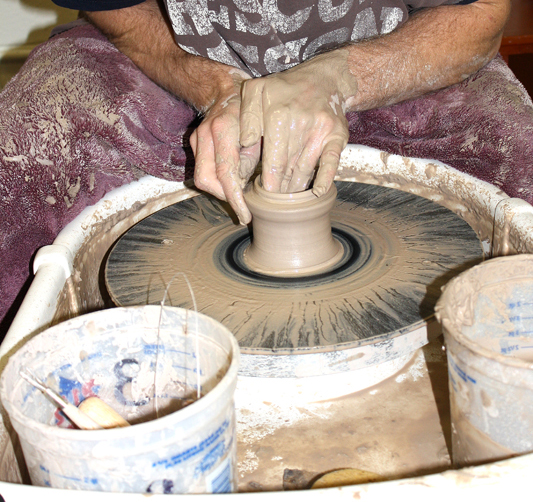
Before taking up her current position as head of training in spiritual direction at the Roanoke Rescue Mission, Kelly Sisson was senior pastor for 17 years at a church in Blacksburg. During that time she sought a creative outlet outside her daily pastoral responsibilities. “I am a very intense, focused person in my work,” she explains. “I tend to give 200 percent, and I realized I needed something that was an outlet to refocus myself.”
Sisson took a clay pottery class through the YMCA at Virginia Tech and “was immediately hooked. There was an immediate connection. Over time, the outlet became a vocation and now it’s so deeply in my being that working with clay is as necessary as breathing to my daily life.”
While on sabbatical from her church duties in 2002, Sisson was approached by The Rescue Mission’s Joy Sylvester Johnson about helping to turn an old kitchen into a pottery studio. At the time the mission was undergoing a major renovation and Sisson accepted Johnson’s offer—which she carried out as a volunteer assignment. When Johnson learned that Sisson was leaving her church, over a year ago, she asked her if she would take on the full-time position of minister for spiritual direction and studio arts—an offer Sisson accepted.
Once the pottery studio was built, it was utilized as a creative arts facility for numerous mediums, before being ultimately transformed into a full-time clay studio to help those with addiction problems understand their recovery.
It’s part of the Rescue Mission’s recovery curriculum for people who stay at the Mission 15 to 18 months and are in an addiction or recovery program. The first part of their treatment is an introduction to a Twelve Step class, taught by Sisson, where participants examine the spiritual aspects of the program and how they will begin applying it to their treatment.
They then advance to a four-week clay class in the studio, where, in Sisson’s words, “we use the clay as a metaphor to understand and put those steps into practice. The [object] is to center the clay so that, even with all the chaos and all the movement in life going on, the clay appears to be unmoved. For all of us in life, we have to learn how to find our own sense of center and sense of spirit within us that can help us with all the chaos we deal with day in and day out in our lives.” During one exercise participants even “throw clay” while wearing a blindfold, striving to keep their pottery centered as it spins on the wheel.
Anger management skills are part of the class—what Sisson calls “de-airing” the clay. “How do we begin to get those pockets of anger out? One of the things we learn is that it splatters back on us. Anytime we inappropriately project anger, then it can splatter everywhere—including back on us. There is a visual when you’re covered in clay to realize there might be another way to deal with this, that might be more healthy.”
Those in the pottery program focus all of their efforts on recovering from addictions. A volunteer service assignment is part of their treatment. The purpose of the pottery program is about the recovery, not commercializing the items those in the program turn out. The program, in Sisson’s words, is “to get a feel for the clay, to understand how it works in relationship to getting an understanding of how an individual works.”
Sisson, whose own pottery has been exhibited and sold at the 2nd Helpings Gallery on Williamson Road, cites a text from the book of Jeremiah in the Hebrew scriptures: “This is just like clay in the potter’s hands. So we are in God’s hands. What does it mean for us to allow ourselves to be molded into something far beyond what we imagined we could be molded into? We really emphasize that part of the process, and we don’t want them working on a product to be sold. We have had people go on to do pottery [outside the Rescue Mission] and we’ve even had a couple of professional potters come out of it. But that’s not our goal.”

